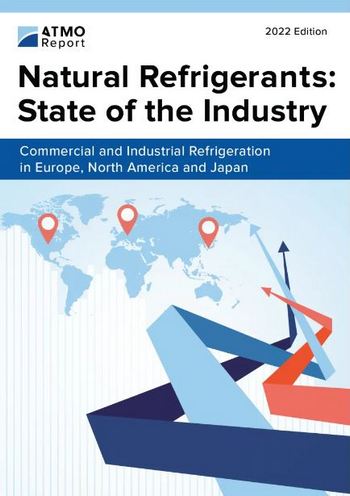ATMOsphere study finds 919,000 self-contained hydrocarbon cabinets in U.S. stores
March 09, 2023

A market study conducted by ATMOsphere, publisher of Hydrocarbons21.com, has estimated that in the U.S. there were 919,000 self-contained hydrocarbon cabinets in U.S. stores as of December 2022. That’s up from 875,000 units, including 500,000 beverage cases, in 2021.
The hydrocarbons include largely propane (R290) and to a lesser extent isobutane (R600a).
The study also estimated that there were an estimated 2.9 million self-contained hydrocarbon cabinets installed at European stores as of December 2022. In 2021, ATMOsphere estimated there were 2.7 million hydrocarbon cases in operation in Europe, including 300,000 units beverage coolers.
The complete updated 159-page market study, “Natural Refrigerants: State of the Industry, Commercial and Industrial Refrigeration in Europe, North America and Japan, 2022 Edition,” can be accessed here for free. An earlier edition focused only on the European market was published last October.
The report also includes market data on installations of transcritical CO2 (R744) systems in Europe, North America and Japan at stores and industrial sites, and installations of industrial low-charge ammonia (R717) systems in Europe and North America. In addition the report looks at economic and policy trends impacting the growth of natural refrigerants in the three markets, as well as general trends and trends in CO2, hydrocarbons and ammonia refrigeration.
“By the end of the decade, natural refrigerants will represent the vast majority of commercial and industrial installations in many parts of the industrialized world,” said Marc Chasserot, Founder and Publisher of ATMOsphere. “It’s only a matter of time before this wave overtakes other applications such as heat pumps, AC and transport refrigeration, among other residential, commercial and industrial applications.”
R290 uptick in 2016
In addition to CO2 in transcritical and cascade/secondary systems, the other natural refrigerant used by U.S. grocers in significant numbers is propane, largely in self-contained display cases at the checkout or in spot merchandising locations. The maximum charge per circuit is currently 150g, but this is expected to increase to 300g for closed cabinets and 500g for open cabinets this year.
In 2012, Unilever began delivering R290-based ice cream chest freezers to U.S. stores. The big uptick in R290 case adoption in the U.S. began in 2016 in anticipation of the more stringent energy standards released in March 2017 by the U.S. Department of Energy (DOE). The need for better energy efficiency boosted adoption of R290, a highly efficient refrigerant, and other technologies such as variable-speed compressors and more efficient fans.
Since then, virtually all of the major commercial display case OEMs have transitioned to hydrocarbon refrigerants. Today, just about every U.S. supermarket deploys at least some hydrocarbon-based beverage coolers at the checkout, and many use them as horizontal ice cream freezers and grab-and-go units in strategic locations.
In addition, a small but growing number of stores are using R290 cases throughout the sales area. For example, as of 2021, about 150 stores had installed R290 cases from AHT throughout the store, and many other stores have deployed R290 cases from Hussmann in large sections or throughout the store. These stores are using semi-plug-in R290 cases attached to waterloop (glycol) systems that remove the heat of condensation.
Hannaford, a New England chain, has been testing R290 in complete frozen-food lineups in some new stores, with heat removed via waterloop. Last year, Hannaford reported that it had equipped the entire frozen section of its new store in Brunswick, Maine, with R290 self-contained cases supplied by Hussmann.
Overall, hydrocarbon self-contained case installations in the U.S. represent a small percentage of the total installed cases in food retail, which are mostly remote cases. In retrofits, remote cases are typically replaced by new remote cases; the exception are horizontal chest “island” freezers that are harder to get to with piping.
Other opportunities exist for hydrocarbon cases in store expansions, club stores and small stores favoring plug-in cases, as well as stores seeking a piecemeal approach to transitioning to natural refrigerants. In the future, some observers say, conventional U.S. supermarket chains interested in naturals may consider transcritical CO2 for perimeter cases and R290 cases in the center store. On the other hand, CO2 condensing units, for which there is growing interest in the U.S., could compete with self-contained R290 cases in smaller stores and with HFO-blend condensing units in convenience stores.


